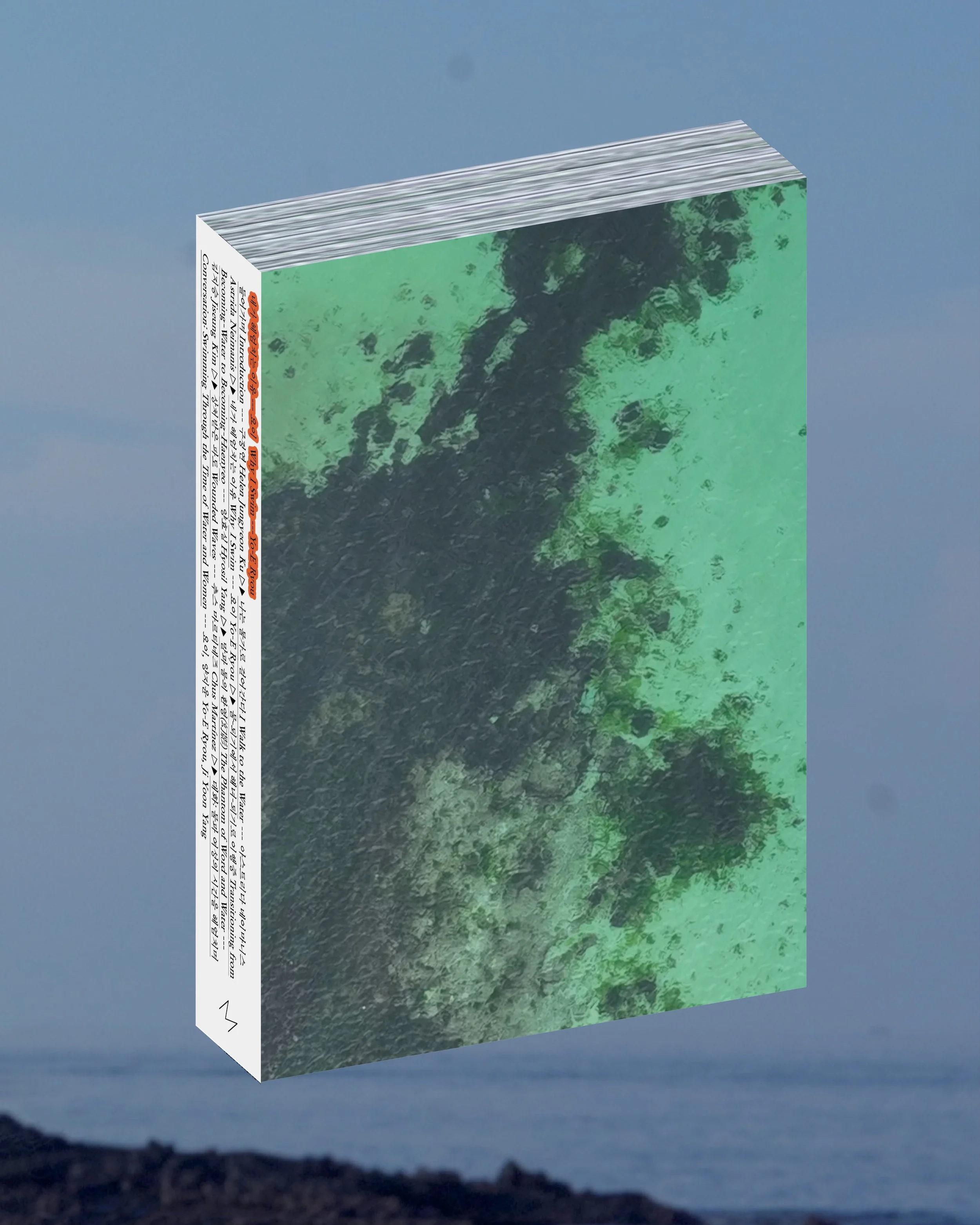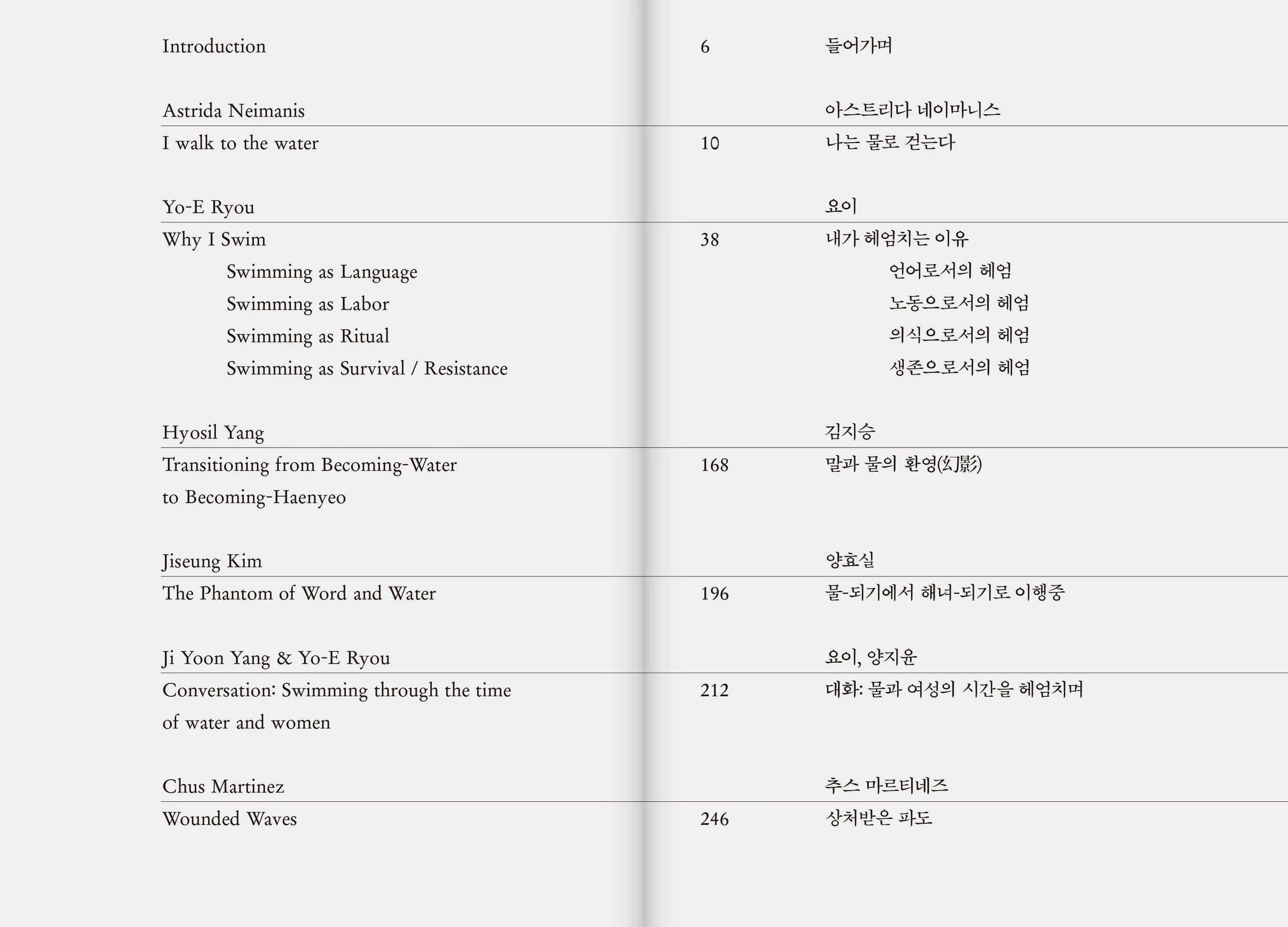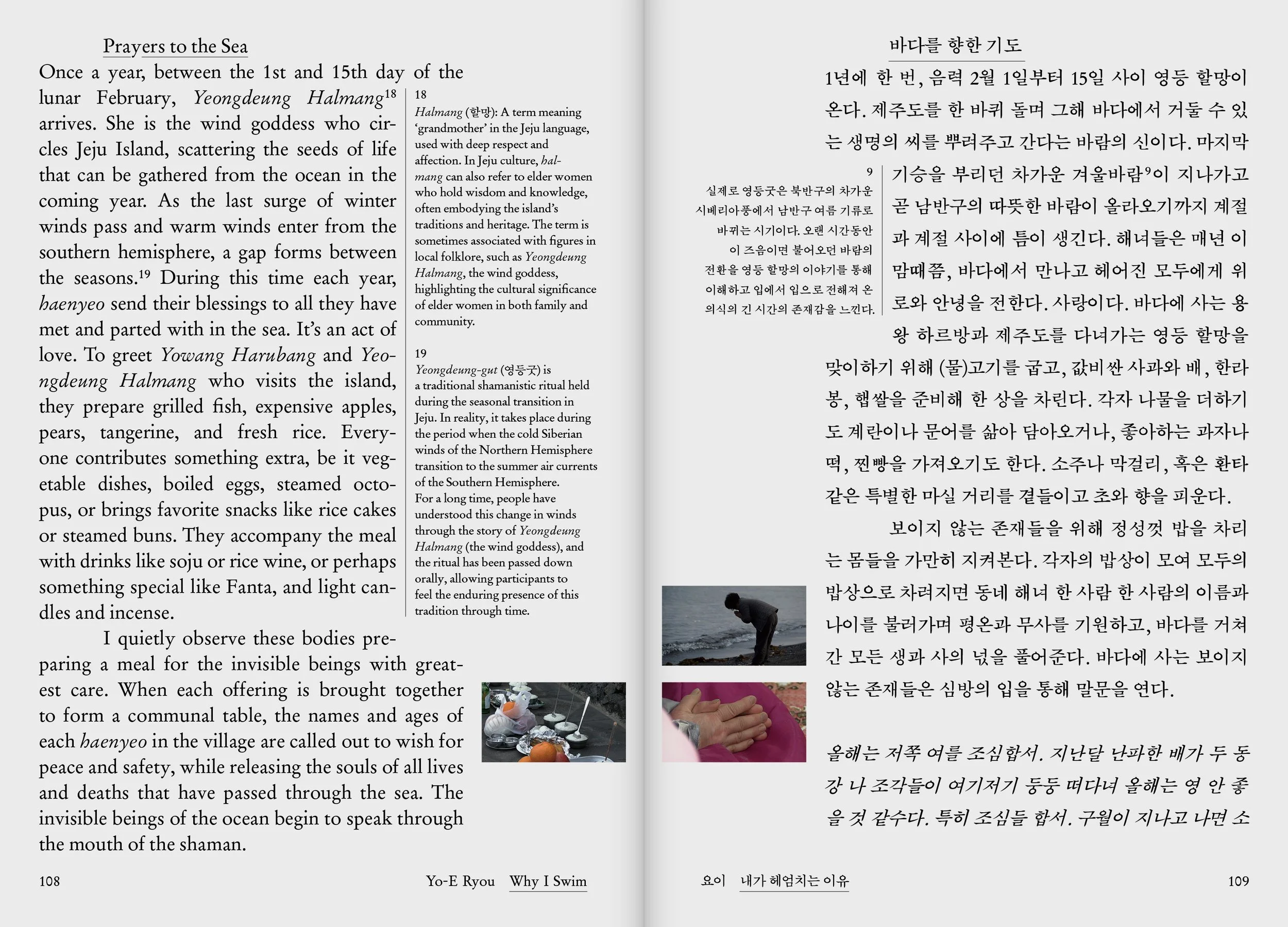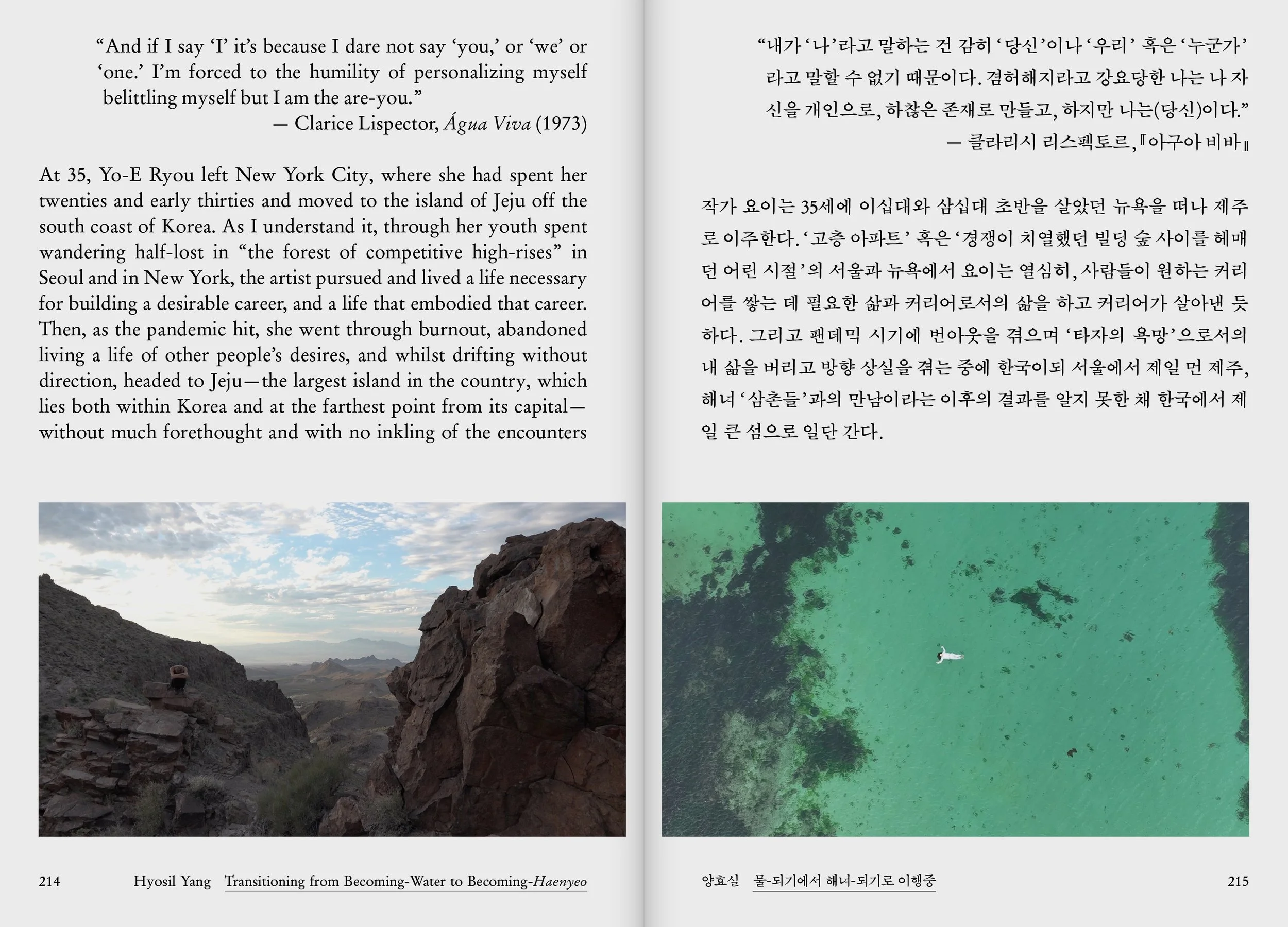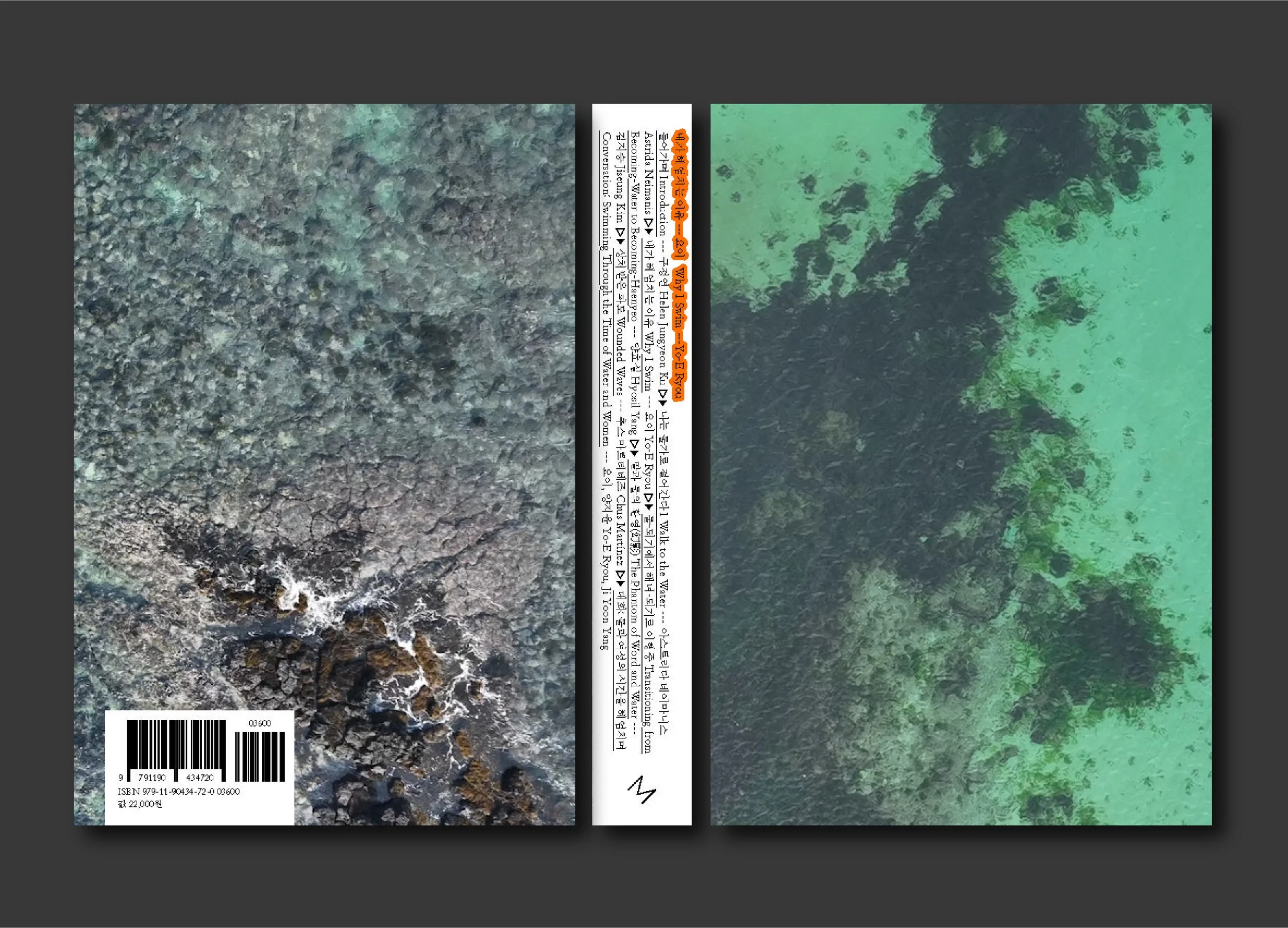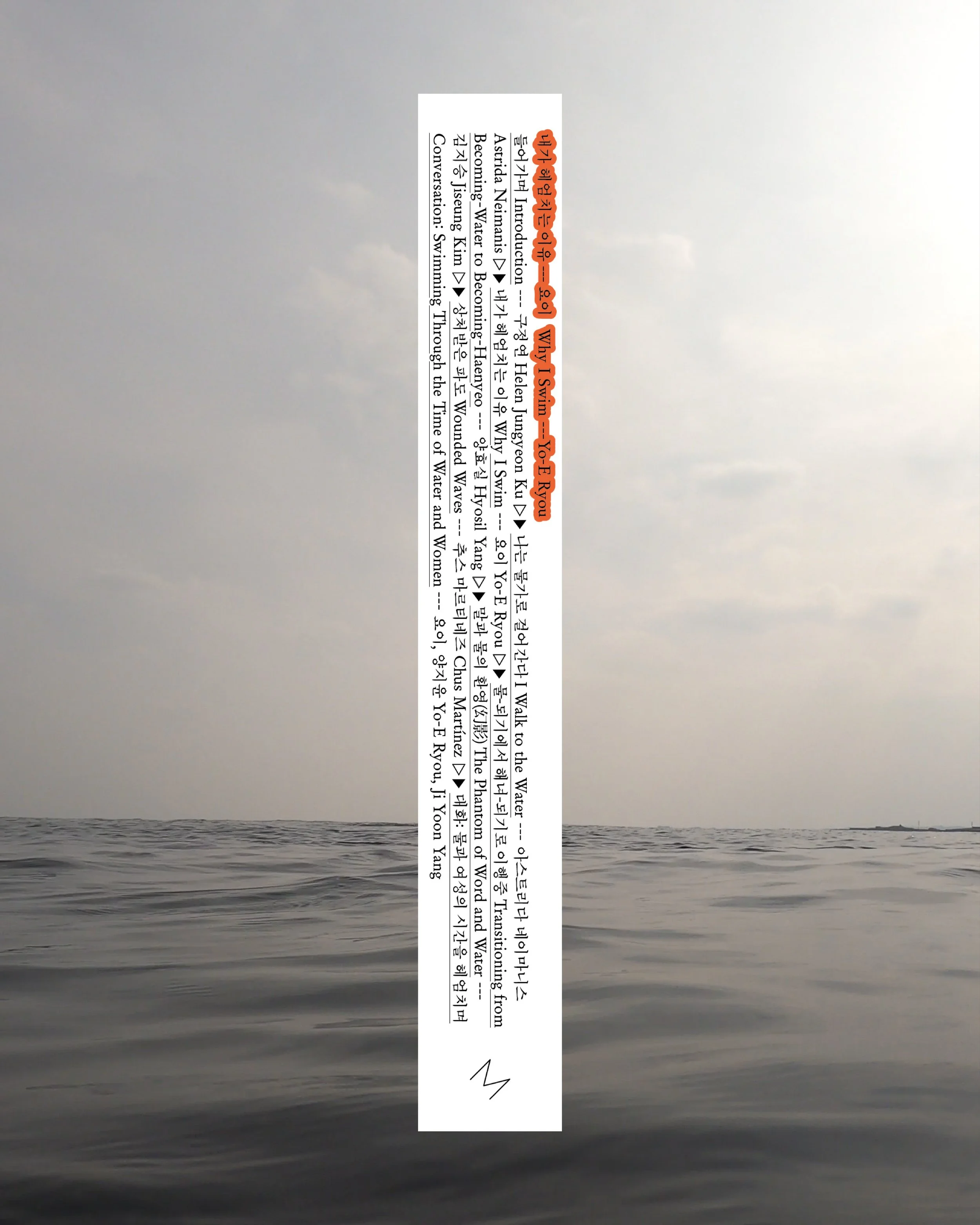Yo-E Ryou: Why I Swim
Artistic Research book, 125x180 mm, 345pages, 2025
ISBN 979-11-90434-72-0 03600
KR https://mediabus.org/Why-I-Swim
US https://www.printedmatter.org/catalog/68331/
EU https://san-serriffe.com/product/yo-e-ryou-why-i-swim/
—
After years of living abroad, artist Yo-E Ryou relocated to Jeju in 2021, where she began forging a new relationship with the sea—one stroke at a time. Having never learned to swim before, she immersed herself in the water, guided by the care and support of the Haenyeo diving community and the Haenyeo School. Over time, she not only learned to swim but also to dive, experiencing an entanglement of her own body with the body of water. Moving from land to sea, from vertical descent to the horizontal flow of the tides, she discovered a new way of being.
This book is a record of that journey. It reflects on the embodied time of water and the body, the lives of Jeju’s Haenyeo grandmothers, and the fading reality of their once-thriving community. It also explores the ‘language of water’—a knowledge passed down through breath, gesture, and memory. Alongside the artist’s reflections, invited authors offer their own perspectives on the sea, examining their personal and cultural connections to water in diverse and unexpected ways.
—
Texts by Astrida Neimanis, Chus Martínez, Hyosil Yang, Jiseung Kim, Ji Yoon Yang, Yo-E Ryou
Edited by Yo-E Ryou, Jungyeon Ku
Translated by Yo-E Ryou, Yewon Lee
English supervision by Catherine Taft
Designed by Shin Shin
Printed in Seoul, Korea
Published April 2025 by mediabus, Seoul
—
Contents
I Walk to the Water / Astrida Neimanis
Why I Swim / Yo-E Ryou
Swimming as Language
Swimming as Labor
Swimming as Ritual
Swimming as Resistance
Transitioning from Becoming -Water to Becoming - Haenyeo / Hyosil Yang
The Phantom of Word and Water / Jiseung Kim
Wounded Waves / Chus Martínez
Conversation: Swimming Through the Time of Water and Women / Yo-E Ryou, Ji Yoon Yang
요이: 내가 헤엄치는 이유
아티스트 리서치북, 125x180mm, 345쪽, 2025
ISBN 979-11-90434-72-0 03600
사라져가는 제주 바다와 해녀들 사이에 스며들어 작가는 그들의 이야기, 그리고 그들이 바다와 공존하고 인간을 넘어선 존재들과 관계맺는 방법을 듣고, 쓰고, 나누며 물-되기를 실험한다. 작가가 물과 관계맺는 과정에서의 대화, 물 속에서 만난 자아와 이웃 여성들, 인간을 넘어선 다양한 종들과의 대화와 사유를 엮는다. 이것은 현대 자본주의와 기술이 지배하는 시대에 아직도 살아 숨쉬는 아름다우면서 모순되고, 고전적이면서도 급진적인 구전문화-몸에 배어있는 이야기들을 해석하고 이해해보려는 시도이다.
—
이 책은 서울문화재단, 제주문화예술재단, (재)예술경영지원센터의 지원을 받아 제작되었습니다.
This publication was made possible with the support of Seoul Foundation of Arts and Culture, Jeju Foundation of Arts and Culture, and Korea Arts Management Service.
-
After many years abroad, Yo-E found home on Jeju Island in 2021. Since then, she began to learn what had been unknown to her for over thirty years—how to swim—and formed a completely new relationship with the sea. Under the care and support of the community of local female divers, haenyeo, and the Haenyeo School, she slowly learned how to dive as well. As her body and bodies of water intertwined, she glided from land to wetland, from a hierarchical to a horizontal world. This book follows her journey. It contains the time of water and the time of body, which she learned through swimming, the lives of the haenyeo, and the reality of their disappearing community. It is also about the ‘language of water’ she acquired through her encounters with them. Alongside her, invited authors explore their own ways of seeing and relating to the ocean.
At the threshold of Yo-E’s autobiographical stories stands a text by Astrida Neimanis. A thinker of hydrofeminism, Neimanis questions the act of touching and being touched by water. How can we sense and perceive water? What are the ways of approaching water? Our water-made bodies seek relations with other waters, moving along shore lines to connect self to place. Her text functions as a ritual, a portal guiding us into the watery time and space Yo-E has experienced.
For Yo-E, swimming is survival, labor, and ritual. Most importantly, in the water, she rediscovers a lost language. She unfolds why she swims, through the four themes of language, labor, ritual, and resistance. Having lived alone abroad for a decade, she spent years adapting to new languages and environments. She learned foreign tongues and sought belonging, yet the distance remained uncrossable. After such a diasporic experience, she lands on Jeju, learning to swim and dive, reclaiming forgotten movements and words. As she entangles herself with the water, the haenyeo, and the ocean, she senses subtle shifts in how her body relates to the world. By surrendering to the water and learning the language of water, her body absorbs new senses, different from before.
Art critic Hyosil Yang, reviewing Yo-E’s two-channel video Why I Swim, examines the journey of bodily reconstruction that unfolds as the artist encounters water and learns to swim as haenyeos do. She reflects on how Yo-E, once an outsider, physically transforms through her encounters with the water. At the same time, facing the reality of the gradually disappearing community, Yang hopes that the stories shared between haenyeo grandmothers and the artist, Yo-E—probably as young as their granddaughters—will continue to be passed down, despite their differences.
The beauty of the moment when different bodies and languages meet lies in the way their differences and plural stories intertwine and merge. Writer Jiseung Kim experiences the slippage of words and bodies in her encounters with the haenyeo. The time of the island is different from the time outside of the island, and there exists an unbridgeable gap between the language of the haenyeo and that of the non-haenyeo. Holding unspoken words in her mouth, she waits for the divers to open a path for conversation. Yet, the words remain unspoken, dissolving into water. And perhaps, as she suggests, this dissolution may not be an end but the very beginning of dialogue.
Curator Chus Martínez reflects on the relationship between nature and art, and the role of the artist within it. She suggests that relating to nature means learning how to feel nature differently, and that artists are the ones who offer new ways to sense the lives of other beings. Through the process of forming an intimate relationship with the ocean, which Yo-E had long lived with her back turned to, Martínez says she can connect with the lives of the haenyeo and other women’s communities in both a poetic and deeply perceptive way. Martínez emphasizes that this type of practice is not only a reconnection with the ocean but also an enactment of interdependence—an understanding that to swim and float in the sea is to embody the entanglement of all living things.
Lastly, through a conversation with curator Ji Yoon Yang, we can listen to Yo-E’s journey to Jeju, her work through Unlearning Space, and the stories with the haenyeo community. This dialogue expands upon an artist’s talk during her solo exhibition, offering further insight into her practice.
Yo-E shares what she has learned from the ocean and the haenyeo. To connect with water is to connect with oneself, others, and another world. The sea overturned everything she had once known. Learning to swim was learning to perceive water—and in doing so, she drew closer to the lives of the grandmothers.
Just as she unlearned one language to learn another, she proposes that new ways of being require an undoing of what we know. This book gathers polyphonic voices around water, a record of moments where bodies and words meet in the tides. It is also a guide—an opening towards the possibility of sensing, perceiving, and being together. Now that the path to water’s embrace lies before us, all that remains is to step forward and follow its way.
—
Helen Jungyeon Ku
Head of Research and Public Programs, Leeum Museum of Art
Co-founder, The Book Society -
Yo-E Ryou
Yo-E Ryou is an artist, educator, and researcher exploring the relationship between water and women’s experiences through a hydrofeminist lens. Currently based on Jeju Island, she engages with the disappearing culture of the haenyeo while learning to swim, dive, and give voice to silenced narratives, experimenting with ‘women’s writing’ across various media. She runs Unlearning Space, an art education and research initiative dedicated to uncovering and interweaving the stories embedded in our bodies. Yo-E studied visual arts and design at Yale University and the Rhode Island School of Design.Astrida Neimanis
Astrida Neimanis writes at the intersection of feminism and environmental change, with a focus on weather, water, and bodies, and often works in collaboration with artists, scientists, poets, and teachers across various communities. They currently live and work on unceded syilx territories, where they are Associate Professor and Canada Research Chair in Feminist Environmental Humanities at UBC Okanagan, and Director of the FEELed Lab.Chus Martínez
Born in Spain, Chus Martínez has a background in philosophy and art history. She is currently Head of the Institute Art Gender Nature at Basel Academy of Art and Design FHNW; Associate Curator at TBA21–Academy, headquartered in Madrid; and Curator-at-Large of the Vulsat Foundation, Istanbul. Martínez has held leadership positions at art institutions across the world, including Chief Curator, El Museo del Barrio, New York; Head of Department, documenta 13, Kassel; Chief Curator, Museu d’Art Contemporani de Barcelona; Director, Frankfurter Kunstverein; and Artistic Director, Sala Rekelde, Bilbao. In 2021–2022 she was Curator of TBA21–Academy’s Ocean Space in Venice, Italy. Her curatorial projects in 2023 include Living in Joy at Art Sonje Center, Seoul. She is currently the artistic director of the 36th Ljubljana Biennale of Graphic Arts.Hyosil Yang
Hyosil Yang is currently a lecturer at Seoul National University and Korea National University of Arts. Main Concerns of Yang's Art Writing and Practices are Feminism, Queer Studies, and Girl Affects. Yang translated Judith Butler's Notes Toward a Performative Theory of Assembly (2020), Parting ways: Jewishness and the Critique of Zionism (2016), Giving an Account of Oneself: A Critique of Ethical Violence (2013) and Precarious Life (2008) into Korean. Her Published Works include Crippling Life, Words of Love (2017), and Imagination Against Power, Chronology of Cultural Movements (2015). She participated in several collections of criticisms as an art critic, concerning contemporary Korean artists such as Im Heung-soon, Bahc Yiso, Hague Yang, and Ahn Eun-mi.Ji Yoon Yang
Ji Yoon Yang is the director of ‘Alternative Space Loop’ and ‘Sound Art Korea’. After participating in the curatorial program at the Amsterdam De Appel Art Center, she worked as the director of 'Corner Art Space' and the chief curator of 'Mimesis Art Museum'. Since 2007, she has been directing ‘Sound Effect Seoul: Seoul International Sound Art Festival’ with Baruch Gottlieb. She explores issues in visual culture that expand the scope of existing contemporary art. She has a steady interest in implementing these issues through public communication using radio, the Internet, and social media.Jiseung Kim
Jiseung Kim has studied literature, cultural theory, and psychoanalysis, conducting personal research and art classes focused on feminine writing and various women’s narratives. She is particularly interested in the humor and sharp wit of elderly women. Currently, she engages in interdisciplinary collaborations, lectures, and writing activities. Her published works include 100-Year Classes, Anyway, Pencil, Beast Diary, and Changing the Seeker.
